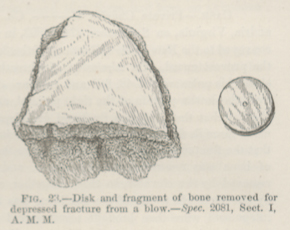Title: negro, name unknown
Source text: Surgeon General Joseph K. Barnes, United States Army, The Medical and Surgical History of the War of the Rebellion. (1861–65.), Part 1, Volume 2 (Washington, D.C.: Government Printing Office, 1870), 58.
Civil War Washington ID: med.d1e3550
TEI/XML: med.d1e3550.xml
CASE.—A negro, whose name was unknown, was brought into the E Street Infirmary, Washington, D. C., with well marked symptoms of compression of the brain, in the latter part of February, 1864. He was examined by Assistant Surgeon J. W. S. Gouley, U. S. A., who found a wound over the right parietal protuberance, caused apparently by a blow from the head of an axe. The scalp was shaved, and it was found that there was a depressed fracture of both tables of the skull, with detachment of a large fragment. It was not practicable to insert the elevator to raise the depressed fragment; to allow this to be done, a disk of bone was removed by the trephine. A triangular fragment, measuring an inch by one and a quarter inches, was then removed and the flaps of the scalp were approximated. The symptoms of compression were relieved, and the patient was doing well three days subsequently, when the specimen, represented in the adjacent wood-cut, (FIG. 23), was forwarded to the Army Medical Museum. The facts above noted are taken from a minute, made upon the reception of the specimen, by Surgeon John H. Brinton, U. S. V. It has been impracticable to learn the ultimate result of the case; but a letter from the late Assistant Surgeon T. G. Mackenzie, U. S. A., dated March 25th, 1864, states that the man was doing well at that date, though his left arm was paralyzed. Dr. Mackenzie refers to an escape of brain substance at the time of the injury; and Dr. Gouley, in forwarding this letter, states that at least half an ounce of brain matter was lost, and comments on the singular good fortune of the patient in recovering without the supervention of cerebral hernia, and without loss or apparent impairment of the mental faculties.
